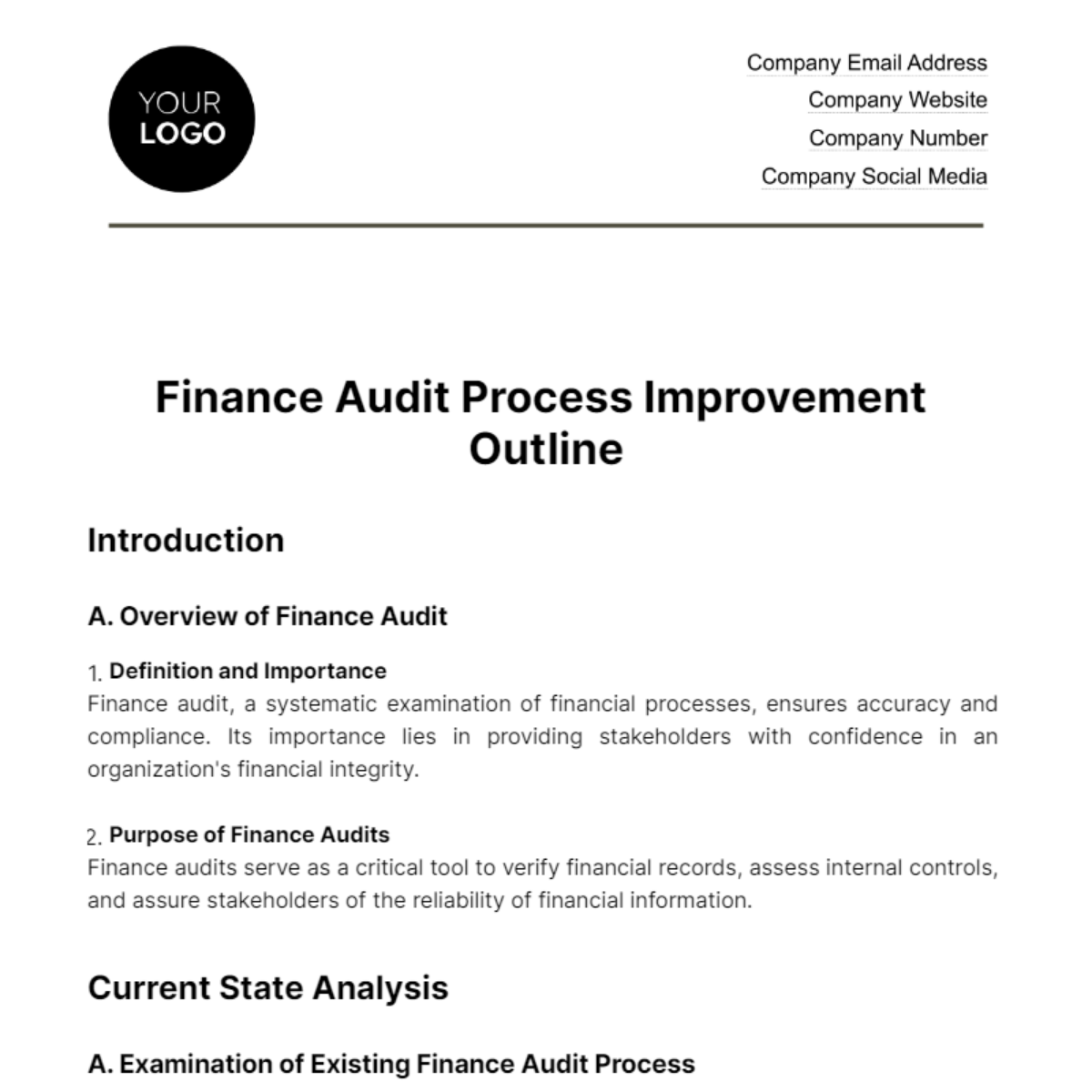Finance Audit Process Improvement Outline
Introduction
A. Overview of Finance Audit
Definition and Importance
Finance audit, a systematic examination of financial processes, ensures accuracy and compliance. Its importance lies in providing stakeholders with confidence in an organization's financial integrity.
Purpose of Finance Audits
Finance audits serve as a critical tool to verify financial records, assess internal controls, and assure stakeholders of the reliability of financial information.
Current State Analysis
A. Examination of Existing Finance Audit Process
Steps and Procedures
Currently, the finance audit involves a multi-step process, including risk assessment, testing, and reporting.
Identification of Strengths and Weaknesses
Strengths include a robust risk assessment, but weaknesses exist in manual data entry, leading to potential errors.
Objectives of Improvement
A. Clearly Defined Goals for the Finance Audit Process
Efficiency Enhancement
The primary goal is to streamline the finance audit process, reducing time and resource consumption.
Accuracy Improvement
Enhance accuracy through the adoption of advanced audit procedures and technologies.
Compliance Strengthening
Strengthen compliance with regulatory standards and industry best practices.
Stakeholder Analysis
A. Identification of Key Stakeholders
Internal Teams
Internal stakeholders, including finance, internal audit, and executive teams, are crucial for successful process improvement.
External Auditors
External audit firms play a vital role in providing an independent perspective on financial processes.
Regulatory Bodies
Engaging regulatory bodies is essential to ensure alignment with compliance requirements.
Best Practices Research
A. Exploration of Industry Standards
Benchmarks in Finance Auditing
Benchmarking against industry standards helps identify areas for improvement and align with best practices.
Emerging Trends and Innovations
Keeping abreast of emerging trends ensures the integration of innovative practices into the finance audit process.
Technology Integration
A. Assessment of Current Technology Usage
Audit Software
The current audit software is effective but lacks automation capabilities, leading to potential inefficiencies.
Automation Tools
Recommendations include the adoption of advanced automation tools to streamline audit procedures.
B. Recommendations for Technological Enhancements
Upgrading audit software and incorporating automation tools will significantly enhance the efficiency of the finance audit process.
Process Redesign
A. Restructuring of Audit Procedures
Streamlining Workflow
Redesigning audit procedures to eliminate redundant steps will streamline the overall workflow.
Introduction of Agile Practices
Implementing agile practices will enhance adaptability and responsiveness in the audit process.
Risk Management
A. Evaluation of Risks Associated with Finance Audit
Mitigation Strategies
Identified risks, such as data security vulnerabilities, will be mitigated through enhanced cybersecurity measures.
Contingency Planning
Contingency plans will be developed to address potential disruptions to the audit process.
Timeline and Milestones
A. Phased Implementation Plan
Short-term Goals
Short-term goals include completing a technology upgrade within the next three months.
Long-term Objectives
Long-term objectives involve achieving full process optimization within the next twelve months.
Budget Allocation
A. Estimation of Costs for Process Improvement
Resource Investment
A budget of [$7,500] is allocated for hiring additional personnel and conducting training programs.
Technology Expenses
Approximately [$10,000] is earmarked for upgrading audit software and implementing automation tools.
Conclusion
A. Summary of the Finance Audit Process Improvement Plan
Expected Outcomes
The plan aims to achieve a [20%] reduction in audit time and a [15%] improvement in accuracy.
Long-term Benefits
Long-term benefits include enhanced stakeholder trust, improved regulatory compliance, and increased overall organizational efficiency.






























